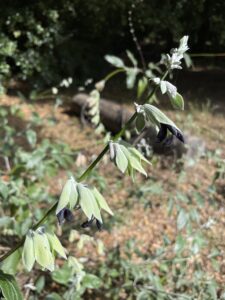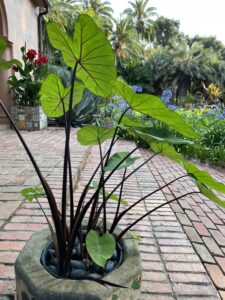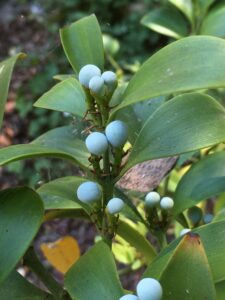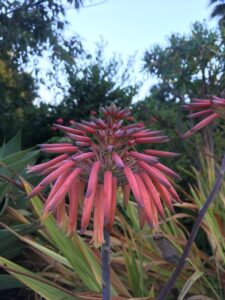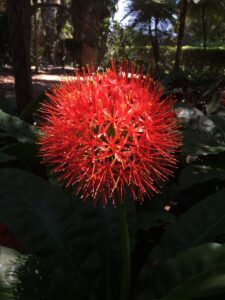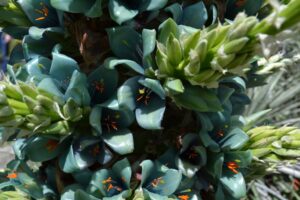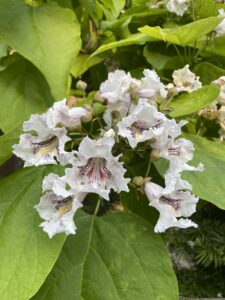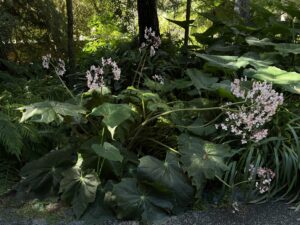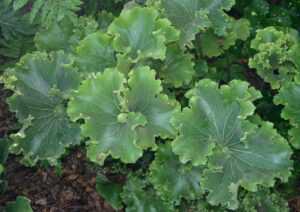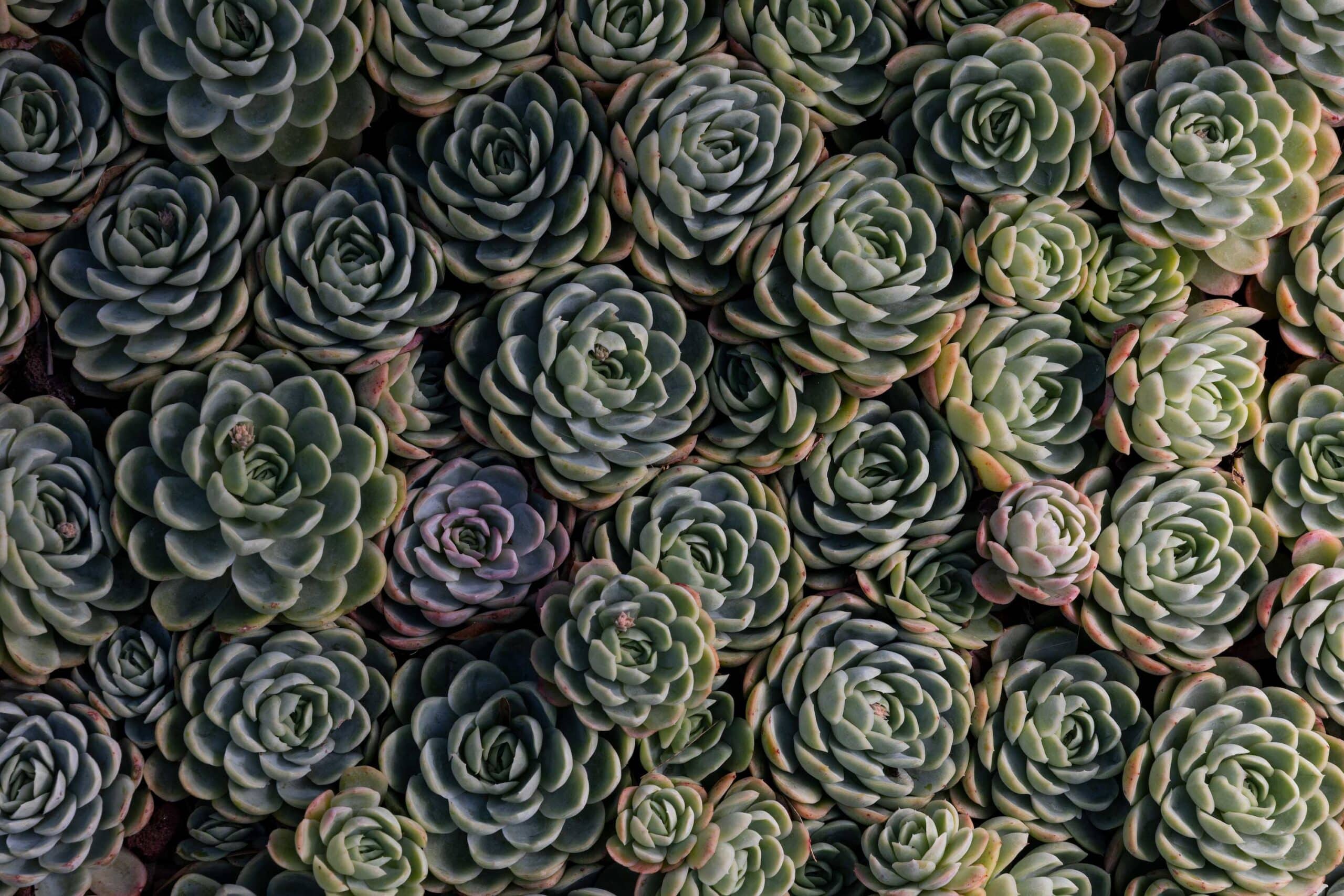
Plant Highlights
July
-
Salvia discolor
Andean silver-leaf sage
Highlight Month:
July
Nativity:
Peru
Growth Habit:
Stems should be pruned back after flowering to encourage bushy growth as this species tends to flop over. It can be grown in the landscape or makes a statement in a container or hanging basket where the white leaf undersides can be viewed from underneath.
Growing Requirements:
It is hardy to USDA Zone 9 and prefers well-drained soils in full to part sun. This species is drought tolerant but can handle more water than our native California Salvia.
Features:
Rare in cultivation, this unusual Peruvian salvia is popular with hummingbirds and is a drought tolerant choice for the garden. Its evergreen aromatic leaves are grey-green with contrasting fuzzy white undersides. The flowers have deep purple petals that appear black against the silver calyces and contain a sweet nectar at the base of the floral tube. The inflorescence stalk is sticky and traps small insects , giving this plant the name “flypaper salvia.” The genus name, Salvia, comes from the Latin, salvus, meaning “to make safe or healthy” in reference to the healing properties of many sages. The specific epithet, discolor, references the bi-colored leaves.
Where at Lotusland:
S. discolor can be found in the Insectary Garden at Lotusland where it blooms summer to fall.
-
Colocasia esculenta ‘Fontanesii’
black taro
Highlight Month:
July
Nativity:
Garden Origin
Growth Habit:
This taro exhibits spectacular purple-black petioles topped with green heart-shaped leaves. If provided with abundant nutrients and water these tender perennials can reach up to 7’ tall. Flowers are bright yellow with a papaya-like scent but rarely seen.
Growing Requirements:
This flexible plant is happy in a pot or the ground and can even withstand being submerged up to 12” in water. It prefers light to part shade and is hardy to USDA Zone 7 with mulching.
Features:
Both the leaves and corms of taro are edible but toxic when raw due to the presence of calcium oxalate crystals. Steaming, boiling, and steeping can minimize the toxin.
Where at Lotusland:
Look for Colocasia esculenta ‘Fontanesii’ in the Water Garden bogs and in pots in front of the Bath House at Lotusland.
-
Nageia nagi
nagi, Asian bayberry
Highlight Month:
July
Nativity:
China, Japan, Taiwan
Growth Habit:
Trees will reach 30-50’ high and 15-25’ wide with a pyramidal shape. Evergreen leaves remain leathery and glossy and trunks display attractive bark exfoliating in patches.
Growing Requirements:
Prefers to grow in well-drained loams but is tolerant of poor soils and drought once established.
Features:
This broadleaf conifer is a member of the podocarp family (Podocarpaceae). Members of this species are dioecious, meaning female cones and male catkins are produced on separate plants. This species is uncommon in cultivation.
Where at Lotusland:
Both male and female Nageia nagi can be found in the Japanese Garden at Lotusland.
-
Aloe distans
jewelled aloe
Highlight Month:
July
Nativity:
This aloe is native to the west coast of the Western Cape of South Africa where it grows in shallow soil on limestone rock. It is known from 8-10 locations in a small range from Danger Point to St. Helena Bay.
Growth Habit:
Aloe distans is a sprawling aloe that develops caulescent suckering stems along the ground. It blooms in mid-summer to fall with capitate heads of coral pink tubular flowers. Leaves are borne in tight rosettes with showy yellow triangular teeth.
Growing Requirements:
It prefers full sun to light shade, is drought tolerant, and is hardy to 20-25°F.
Features:
The specific epithet, distans, means “standing apart” or “far removed,” in reference to its geographic separation from similar creeping Aloe species. However, some authorities consider Aloe distans a coastal subspecies of Aloe mitriformis.
Where at Lotusland:
Aloe Garden
-
Scadoxus multiflorus ssp. katherinae
blood lily
Highlight Month:
July
Nativity:
South Africa
Growth Habit:
Scadoxus multiflorus ssp. katherinae multiplies quickly via underground rhizomes arising from the parent bulb and goes dormant in the winter months. In the summer, 1’ tall stems bear large globes of pink-red flowers that resemble an exploding firework, and the flowers are followed by decorative red fruits.
Growing Requirements:
Plant the bulbs 2 feet apart in light to full shade. Water regularly during the spring/summer growing season. Scadoxus is sensitive to frost, however in colder regions the bulbs can be stored indoors for the winter dormant season. They will also grow well as a container plant.
Features:
This bulb in the Amaryllidaceae family is from coastal and swamp forests in the Eastern Cape of South Africa. The common name “blood lily” references the red-speckled bulb. The subspecies katharinae is a more robust plant that grows in wetter regions than the straight species (ssp. multiflorus).
Where at Lotusland:
Fern Garden
-
Puya alpestris
sapphire tower
Highlight Month:
July
Nativity:
The Andes of southern Chile
Growth Habit:
This plant forms clumps 4-5 foot tall with the foliage in many rosettes. The leaves are very narrow with spiny edges and are silver on the underside. The clumps can reach ten feet across.
Growing Requirements:
This dry-climate bromeliad does best in full sun to light shade. It is drought tolerant, needing little water. It adapts to poor soils and prefers good drainage.
Features:
In spring the plant produces five foot tall stalks bearing clusters of bell shaped flowers that are an unusual metallic turquoise. In the center of the flower are bright orange anthers. The bare lateral branches on the flower spikes provide perches for pollinating birds.
Where at Lotusland:
A very large clump of Puya alpestris grows in the Insectary Garden.
-
Catalpa speciosa
northern catalpa
Highlight Month:
July
Nativity:
Eastern United States
Growth Habit:
Deciduous trees with large pale green leaves to 80 feet in height. White tubular flowers with purple and yellow streaks and blotches in the throat are followed by long, thin seed pods giving it its common name.
Growing Requirements:
Full sun and regular water.
Features:
This member of the Bignoniaceae – the trumpet creeper family – litters the ground below with fragrant flowers in early summer.
Where at Lotusland:
In the Japanese Garden next to the Main Drive.
-
Begonia ‘Carousel’
Highlight Month:
July
Nativity:
Garden Origin
Growth Habit:
This is one of the many rhizomatous hybrid begonias. It forms a spreading clump of bright green leaves that are a great backdrop to the proliferous pink and white flowers.
Growing Requirements:
Grow in soil enriched with plenty of organic material. Keep uniformly moist. Most begonias grow best in partial shade.
Features:
Good to bring color and interest to the shade garden.
Where at Lotusland:
Fern Garden
-
Begonia ‘Lotusland’
Highlight Month:
July
Nativity:
Garden Origin
Growth Habit:
This variety is in the rhizomatous group of the large genus Begonia. Thick horizontal stems creep along the ground and support large, lobed leaves and sprays of small deep pink flowers.
Growing Requirements:
Light to deep shade and regular water.
Features:
This variety was introduced into cultivation by Rudy Ziesenhenne, a begonia grower and taxonomist, who had a nursery in Santa Barbara. It was a chance seedling in his greenhouse without a name until Ziesenhenne was prodded by a National Geographic photographer to give it one. At the time, many begonias were being planted in a new Fern Garden at Lotusland, so he honored Madame Walska by naming this new hybrid after her estate.
Where at Lotusland:
Fern Garden
-
Farfugium japonicum ‘Crispatum’
leopard plant
Highlight Month:
July
Nativity:
Garden Origin
Growth Habit:
Farfugium grows in clumps of leaves to two and a half feet tall. In bright light situations, it will produce a tall inflorescence (to three feet) with a cluster of bright yellow flowers. Farfugium are members of the Asteraceae, or sunflower family.
Growing Requirements:
Light to deep shade and regular water.
Features:
The species is native to Japan, Taiwan and Korea. Horticulturists have made many selections for various growth habits. This cultivar has crimped and ruffled leaves in contrast to the very smooth edges of the species. Lotusland is home to other cultivars featuring yellow-splotched (“Aureo-maculata”) and white-variegated (‘Argentea’) leaves, as well as the giant variety, F. japonicum v. giganteum.
Where at Lotusland:
Fern Garden


